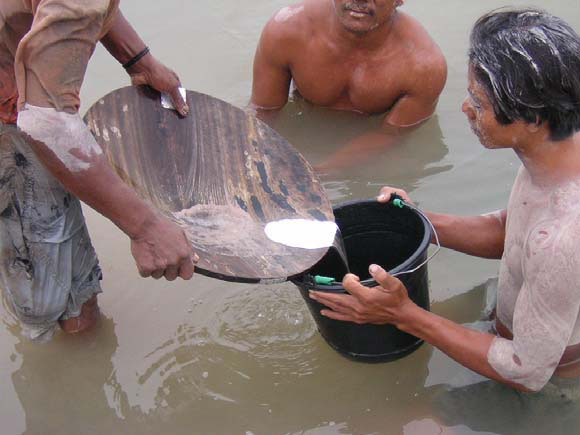In Artisanal and Small-Scale Gold Mining (ASGM), the amalgamation process, tailings processing, and gold recovery from the amalgam result in substantial release of mercury into the environment. By some estimates, release of mercury from ASGM exceeds 1 million kg each year. This level of mercury pollution may exceed the combined emissions of coal combustion, cement production, chlor-alkali plant operation, and large-scale industrial mining and metallurgy. It is therefore important to look at each stage of common ASGM practices to identify how mercury is released into the environment so that measures can be taken to prevent such emissions and mitigate harm. The primary sources of these emissions are from tailings discharge to land and water and mercury gas emissions during amalgam roasting.
In the amalgamation process substantial amounts of mercury can be lost in the tailings. In particular, milling ore and mercury in trommels can result in the formation of tiny mercury droplets that become finely dispersed in the tailings. This “mercury flour” is especially problematic because it can be easily washed away with water and transported far from the mining site. In some cases, mercury-rich tailings can travel in rivers hundreds of kilometers from the mine. The floured mercury is also difficult to recover because it does not coalesce efficiently. In cases in which the tailings are released directly into the environment, the mercury contaminates water and soil, where it is difficult to recover or remediate. These tailings may contain between 50 and 5000 mg mercury per kg ore, resulting in a substantial loss of mercury. This lost mercury may also contain up to 14 % gold by mass, so significant amounts of gold are lost in tailings too. These tailings are sometimes sold for further processing in large tanks using cyanide leaching. The cyanide complexes and dissolves the residual gold. The gold is then recovered by the addition of activated carbon, which is, in turn, isolated and burned (often in open drums).
As much as 20 g of gold can be isolated for every tonne of tailings. Because mercury is also solubilized through cyanide leaching, release of this water into the environment—either through direct release or by way of drainage from unsecured tailing ponds—is a significant source of mercury pollution.

